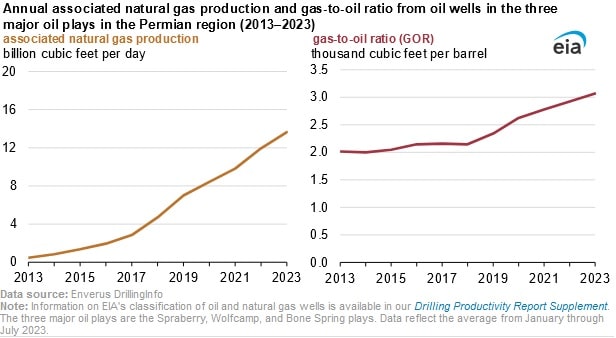Associated Natural Gas Production Significantly Higher During 2023 In Top Three Permian Oil Plays: EIA

Associated natural gas production from the highest three yielding tight oil plays in the Permian region (Wolfcamp, Spraberry and Bone Spring) averaged a total of 13.7 billion cubic feet per day (bcf/d) during the first seven months of 2023, nearly triple the production level of 4.7 Bcf/d in 2018, according to a Dec. 6 report published by the U.S. Energy Information Administration. The increase in associated natural gas production can be attributed to an increase in crude oil production and the amount of gas per barrel of oil that a well yields. This is usually measured by the gas to oil ratio, or GOR, which can be defined as the ratio of the volume of gas that comes out of solution to the volume of oil. An increase in the GOR in an oil well means that a larger amount of natural gas per barrel of oil is being produced.
The Permian region accounts for around 40 percent of total U.S. crude oil production. Moreover, the region is a large natural gas producer and accounts for around 25 percent of total U.S. marketed natural gas production. The Permian region mostly produces associated natural gas and as a result, higher crude oil production has also led to elevated associated natural gas production. Producers in the Permian Basin react to changes in the crude oil price when projecting their exploration and production actions because most of the natural gas production in the Permian Basin is associated with natural gas produced from oil wells.
According to the agency’s Drilling Productivity Report average crude oil production rose by 68 percent in the Permian during the first nine months of 2023, compared to 2018. Consequently, natural gas production in the region rose by 104 percent over the same period, in comparison to 2018.
During 2023, the Wolfcamp, Spraberry and Bone Spring plays generated a total higher volume of 13.2 bcf/d associated natural gas than in 2013. The rise can be attributed to greater crude oil generation, which consisted of 65 percent of the increase in natural gas production and a 35 percent increase came from an elevated GOR.
EnerKnol Pulses like this one are powered by the EnerKnol Platform—the first comprehensive database for real-time energy policy tracking. Sign up for a free trial below for access to key regulatory data and deep industry insights across the energy spectrum.
ACCESS FREE TRIAL